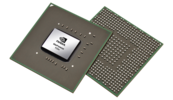NVIDIA GeForce 920M vs Intel HD Graphics 620
NVIDIA GeForce 920M
► remove from comparison
The NVIDIA GeForce 920M (sometimes also NVIDIA GeForce GT 920M) is an entry level DirectX 12 graphics card. It is based on the 28 nm Kepler architecture and uses the same GK208 chip as the GeForce GT 730M, 825M and 740M. The 384 shaders are clocked at 954 MHz, while the memory (64-bit DDR3 interface) runs at 900 MHz (1800 MHz effective).
Architecture
GK208 is based on the Kepler architecture and offers two shader blocks, called SMX, each with 192 shaders for a total of 384 shader cores. The shaders are clocked at the same speed as the rest of the chip. Furthermore, the GK208 chip has 16 TMUs and 8 ROPs on a 64-bit memory interface.
PCIe 3.0 is now supported by the mobile Kepler series and GPU Boost 2.0 mode can automatically overclock the card if the laptop cooling system allows it. This feature is available on any notebook with a graphics card from the 800M series.
Performance
The GeForce 920M offers a performance similar to the AMD Radeon R7 M260 or R7 M360 and will handle modern games (as of 2014/2015) in low settings only. For comparison, a GeForce 930M is about 20 to 30 percent faster than the 920M.
Features
The feature set of the 920M corresponds to the GT 730M and 825M. This includes support for up to 4 active displays. Furthermore, high resolution monitors of up to 3840x2160 pixels can now be connected using DisplayPort 1.2 or HDMI 1.4a if available. HD-Audio codecs, such as Dolby TrueHD and DTS-HD, can be transmitted via bitstream mode through the HDMI port. However, as most laptops will feature Optimus, the integrated GPU will likely have direct control over the display ports and may limit the feature set available by the Nvidia Kepler cards.
The 5th generation PureVideo HD video processor (VP5) offers hardware decoding of HD videos. Common codecs such as MPEG-1/2, MPEG-4 ASP, H.264 and VC1/WMV9 are fully supported up to 4K resolutions while VC1 and MPEG-4 are supported up to 1080p. Two streams can be decoded in parallel for features such as Picture-in-Picture. Another feature is the inclusion of a dedicated video encoding engine similar to Intel QuickSync that can be accessed via the NVENCI API.
Power Consumption
The power consumption of the GeForce 920M is similar to the 825M and suited for 13-inch laptops and above.
Intel HD Graphics 620
► remove from comparison
The Intel HD Graphics 620 (GT2) is an integrated graphics unit, which can be found in various ULV (Ultra Low Voltage) processors of the Kaby Lake generation. This "GT2" version of the Kaby Lake GPU is clocked at up to 1050 MHz (depending on the CPU model). Due to its lack of dedicated graphics memory or eDRAM cache, the HD 620 has to access the main memory (2x 64bit DDR3/DDR4).
Performance
The exact performance of the HD Graphics 620 depends on various factors like L3 cache size, memory configuration (DDR3/DDR4) and maximum clock rate of the specific model but is very similar to the old HD Graphics 520 GPU. That means only some less demanding recent games like Farming Simulator 17 run fluently in low detail settings (see below for gaming benchmarks). Compared to dedicated graphics cards, the HD620 should be positioned between a GeForce 910M and 920M from Nvidia. For games, the drivers however are not that fast updated and tested as with GeForce graphics cards.
Features
The revised video engine now supports H.265/HEVC Main10 profile in hardware with 10 bit colors. Furthermore, Googles VP9 codec can also be hardware decoded. The first models do not support HDCP 2.2 and therefore Netflix 4K. This was added with the new models in 2017 and beginning of May 2017 also the older CPU models like the i3-7100U are now shipped with a new S-Spec Code that supports HDCP 2.2. HDMI 2.0 however is still only supported with an external converter chip (LSPCon).
Power Consumption
The HD Graphics 620 can be found in mobile processors specified at 15 W TDP and is therefore suited for compact laptops and ultrabooks.
| NVIDIA GeForce 920M | Intel HD Graphics 620 | |||||||||||||||||||||||||||||||||||||||||||||||||||||||||||||||||||
| Gen. 9.5 Series |
|
| ||||||||||||||||||||||||||||||||||||||||||||||||||||||||||||||||||
| Codename | N16V-GM-S | Kaby-Lake GT2 | ||||||||||||||||||||||||||||||||||||||||||||||||||||||||||||||||||
| Architecture | Kepler | Gen. 9.5 Kaby Lake | ||||||||||||||||||||||||||||||||||||||||||||||||||||||||||||||||||
| Pipelines | 384 - unified | 24 - unified | ||||||||||||||||||||||||||||||||||||||||||||||||||||||||||||||||||
| Core Speed | 954 MHz | 300 - 1050 (Boost) MHz | ||||||||||||||||||||||||||||||||||||||||||||||||||||||||||||||||||
| Memory Speed | 1800 MHz | |||||||||||||||||||||||||||||||||||||||||||||||||||||||||||||||||||
| Memory Bus Width | 64 Bit | 64/128 Bit | ||||||||||||||||||||||||||||||||||||||||||||||||||||||||||||||||||
| Memory Type | DDR3 | DDR3/DDR4 | ||||||||||||||||||||||||||||||||||||||||||||||||||||||||||||||||||
| Max. Amount of Memory | 4 GB | |||||||||||||||||||||||||||||||||||||||||||||||||||||||||||||||||||
| Shared Memory | no | yes | ||||||||||||||||||||||||||||||||||||||||||||||||||||||||||||||||||
| API | DirectX 12 (FL 11_0), Shader 5.0, OpenGL 4.5 | DirectX 12_1, OpenGL 4.4 | ||||||||||||||||||||||||||||||||||||||||||||||||||||||||||||||||||
| Transistors | 1.3 Billion | |||||||||||||||||||||||||||||||||||||||||||||||||||||||||||||||||||
| technology | 28 nm | 14 nm | ||||||||||||||||||||||||||||||||||||||||||||||||||||||||||||||||||
| Features | Optimus, PhysX, Verde Drivers, CUDA, 3D Vision, 3DTV Play, GPU Boost 2.0 | QuickSync | ||||||||||||||||||||||||||||||||||||||||||||||||||||||||||||||||||
| Date of Announcement | 27.01.2015 | 30.08.2016 | ||||||||||||||||||||||||||||||||||||||||||||||||||||||||||||||||||
| Link to Manufacturer Page | www.geforce.com |
| |||||||||||||||||||||||||
Benchmarks
3DM Vant. Perf. total + NVIDIA GeForce 920M
specvp11 snx-01 + NVIDIA GeForce 920M
specvp12 sw-03 + Intel HD Graphics 620
Cinebench R15 OpenGL 64 Bit + NVIDIA GeForce 920M
GFXBench T-Rex HD Offscreen C24Z16 + NVIDIA GeForce 920M
Average Benchmarks NVIDIA GeForce 920M → 100% n=30
Average Benchmarks Intel HD Graphics 620 → 115% n=30
* Smaller numbers mean a higher performance
1 This benchmark is not used for the average calculation
Game Benchmarks
The following benchmarks stem from our benchmarks of review laptops. The performance depends on the used graphics memory, clock rate, processor, system settings, drivers, and operating systems. So the results don't have to be representative for all laptops with this GPU. For detailed information on the benchmark results, click on the fps number.

League of Legends
2019
Dirt Rally 2.0
2019
Far Cry New Dawn
2019
Metro Exodus
2019
Just Cause 4
2018
Darksiders III
2018
Farming Simulator 19
2018
Fallout 76
2018
Forza Horizon 4
2018
FIFA 19
2018
F1 2018
2018
Monster Hunter World
2018
The Crew 2
2018
Far Cry 5
2018
X-Plane 11.11
2018
Fortnite
2018
Call of Duty WWII
2017
ELEX
2017
The Evil Within 2
2017
FIFA 18
2017
Ark Survival Evolved
2017
F1 2017
2017
Team Fortress 2
2017
Dirt 4
2017
Rocket League
2017
Prey
2017
For Honor
2017
Resident Evil 7
2017
Watch Dogs 2
2016
Titanfall 2
2016
Farming Simulator 17
2016
Battlefield 1
2016
Civilization 6
2016
FIFA 17
2016
No Man's Sky
2016
Overwatch
2016
Doom
2016
Need for Speed 2016
2016
Hitman 2016
2016
The Division
2016
Far Cry Primal
2016
XCOM 2
2016
Rainbow Six Siege
2015
Just Cause 3
2015
Fallout 4
2015
Anno 2205
2015
FIFA 16
2015
World of Warships
2015
Metal Gear Solid V
2015
Mad Max
2015
Dota 2 Reborn
2015
The Witcher 3
2015
Dirt Rally
2015
GTA V
2015
Battlefield Hardline
2015
Evolve
2015
The Crew
2014
Far Cry 4
2014
F1 2014
2014
The Evil Within
2014
Ryse: Son of Rome
2014
Alien: Isolation
2014
Fifa 15
2014
Sims 4
2014
Risen 3: Titan Lords
2014
GRID: Autosport
2014
Watch Dogs
2014
Thief
2014
Battlefield 4
2013
Total War: Rome II
2013
Company of Heroes 2
2013
Metro: Last Light
2013
BioShock Infinite
2013
Tomb Raider
2013
Crysis 3
2013
Hitman: Absolution
2012
Counter-Strike: GO
2012
Diablo III
2012
Anno 2070
2011
Batman: Arkham City
2011
Mafia 2
2010
StarCraft 2
2010Average Gaming NVIDIA GeForce 920M → 100%
Average Gaming 30-70 fps → 100%
Average Gaming Intel HD Graphics 620 → 87%
Average Gaming 30-70 fps → 90%
For more games that might be playable and a list of all games and graphics cards visit our Gaming List



















































